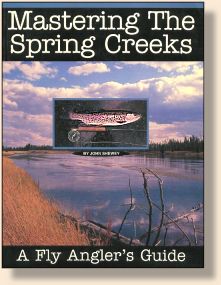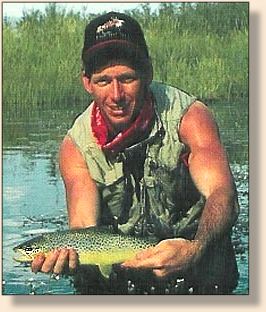|
The Internet is a powerful resource. It provides us instant
access to information, and brings us together via email,
bulletin boards, chat rooms, and instant messaging. FAOL
is a wonderful example of the Internet at its best. The Internet,
however, will never replace the printed page.
I've loved books and fishing since my youngest years, although
I did not start fly fishing until 1993. This column will give
me an opportunity to share reviews of some of my favorite fly
fishing and tying books (and some that are not such favorites)
with my friends here at FAOL. My library reflects my tastes
and interests, and so will this column. It will be heavily
slanted towards cold water fishing and tying for trout and
steelhead, and won't touch much on areas of which I know little,
such as warm or salt water fishing.
I hope that these reviews will motivate some of you to pick up
a good book, on this or any subject, and read.
~ Stu Farnham
Mastering the Spring Creeks: A Fly Angler's Guide
 Mastering the Spring Creeks: A Fly Angler's Guide
by John Shewey
Mastering the Spring Creeks: A Fly Angler's Guide
by John Shewey
Softcover: 144 pages; May 1995
Publisher: Frank Amato Publications, Inc.
ISBN: 1571880003
John Shewey is a fly fisherman, fly tier, bird hunter,
and writer from Salem, Oregon. John is probably best
known for some of his steelhead patterns, including the
Bedsprings Spey and the Spawning Purple. He's written
books on fly fishing for steelhead, spey and dee flies,
as well as fly fishing and wingshooting guides for states
in the Pacific Northwest. John also operates a small-scale
business supplying high quality materials to tiers of
salmon and steelhead flies.
I seldom hear mention of his book, Mastering the
Spring Creeks. It's unfortunate that this book
is so little known, because it is a good one. Many trout
fly fishers consider spring creeks to represent the epitome
of their sport. Smooth flowing, clear waters, abundant hatches,
and, in many cases, heavy fishing pressure result in highly
selective fish populations. Tippets must be long and fine,
flies must match the hatch closely (although a guide from
Dan Bailey's swears that one can do well by fishing a Chernobyl
Ant when fish on Armstrong's Spring Creek get very picky),
and presentations must be perfect. These waters are the North
American analogue to the fabled chalk streams of England.

Sheweys' may be the only book specifically written to address
the challenges of this sort of fishing. The book is divided
into three chapters; the sections in each chapter are separated
by pages from what John calls his spring creek diary, each
recounting an experience from a particular day on a Western
spring creek.
The first chapter of the book covers presentation. I make
no secret of belonging to the school that holds that
presentation dominates all other considerations in its
importance to successful fly fishing for trout. The
chapter begins with a section dealing with the sometimes
neglected topics of approach and positioning. My belief
is you often get only one drift over or past a spring creek
trout. Getting into position to make that presentation without
spooking the fish is critical.
Casting and line management are also important, and the
second section covers these in detail. Since the creeks
that John covers are located in the West, he also includes
information on dealing with the wind. Three of the most
famous U.S. creeks - Armstrong's, DePuy's, and Nelson's -- are
located at the North end of Paradise Valley outside of Livingston,
Montana, where the winds rush up the Yellowstone and are
funneled through a notch in the mountains. It's a rare day
when you don't have to contend with wind there, especially
on a summer afternoon.
The third section introduces another important topic, fly
selection, and provides a nice segue into chapter two,
which covers spring creek trout foods and the flies which
imitate them. There are sections on all the important
insect groups, including discussions of the major hatches
and patterns to imitate each. There is also a separate
section on nymphing techniques for spring creeks.
The final part of the book is for winter daydreaming and
trip planning. Here John talks about the best known Western
spring creeks: the Henry's Fork; Silver Creek; Hat Creek
and the Fall River in California; the Williamson and
Metolius Rivers in Oregon; and Washington state's Rocky
Ford. Along with descriptions of each fishery are hatch
charts broken out by season.
The book is accompanied by clear, detailed drawings illustrating
key points from the text, as well as wonderful color photos
of spring creek waters and insects. There are also color
photo sequences illustrating much of the material in the
presentation chapter.
My one complaint about the book is with the fly photographs.
While these are large and crisply detailed, the color control,
at least my copy of the book, is poor, and the flies in each
photo tend to be somewhat monochromatic.
If you love the challenge of spring creek fishing, I
strongly urge you to find a copy of this book.
~ Stu Farnham
About Stu
 Stu Farnham is a New Englander by birth, who was transplanted to
and put down roots in Oregon in the early 1990s, now residing in
the Seattle area. A software engineering manager by vocation,
he can be found in his spare time chasing trout and steelhead
in the rivers of the Pacific Northwest, chasing his four Gordon
Setters (who in turn are chasing chukar), tying flies, reading,
or working on his website. Colleen, his long suffering wife of
28 years, is a professionally trained personal chef.
Stu Farnham is a New Englander by birth, who was transplanted to
and put down roots in Oregon in the early 1990s, now residing in
the Seattle area. A software engineering manager by vocation,
he can be found in his spare time chasing trout and steelhead
in the rivers of the Pacific Northwest, chasing his four Gordon
Setters (who in turn are chasing chukar), tying flies, reading,
or working on his website. Colleen, his long suffering wife of
28 years, is a professionally trained personal chef.
|

 Mastering the Spring Creeks: A Fly Angler's Guide
by John Shewey
Mastering the Spring Creeks: A Fly Angler's Guide
by John Shewey Stu Farnham is a New Englander by birth, who was transplanted to
and put down roots in Oregon in the early 1990s, now residing in
the Seattle area. A software engineering manager by vocation,
he can be found in his spare time chasing trout and steelhead
in the rivers of the Pacific Northwest, chasing his four Gordon
Setters (who in turn are chasing chukar), tying flies, reading,
or working on his website. Colleen, his long suffering wife of
28 years, is a professionally trained personal chef.
Stu Farnham is a New Englander by birth, who was transplanted to
and put down roots in Oregon in the early 1990s, now residing in
the Seattle area. A software engineering manager by vocation,
he can be found in his spare time chasing trout and steelhead
in the rivers of the Pacific Northwest, chasing his four Gordon
Setters (who in turn are chasing chukar), tying flies, reading,
or working on his website. Colleen, his long suffering wife of
28 years, is a professionally trained personal chef.
